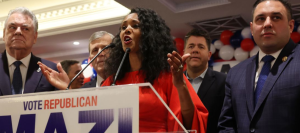In the aftermath of Tuesday’s special election, where Democrat Tom Suozzi secured victory over Republican nominee Mazi Melesa Pilip to fill the seat vacated by scandal-tainted former GOP Rep. George Santos, political analysts are dissecting the implications for November’s electoral landscape. While Suozzi’s win in New York’s Third Congressional District marked a setback for Republicans, there’s a nuanced view on whether this outcome portends a broader trend for the upcoming midterm elections.

The eight-point margin of victory for Suozzi in the swing district, as reported by The Associated Press, raised questions about the dynamics at play. According to insights shared with the Daily Caller News Foundation (DCNF) by polling analysts and political observers, the circumstances surrounding Santos’s tenure and specific local factors likely contributed to Suozzi’s success. However, cautionary notes were sounded regarding the broader advantages Democrats may enjoy as November approaches.
Jon McHenry, a GOP polling analyst at North Star Opinion Research, emphasized that while the loss doesn’t guarantee a Democratic House takeover, it serves as a reminder for Republicans to not solely rely on external factors such as an unfavorable political climate for Democrats or dissatisfaction with President Biden. McHenry stressed the importance of adequate campaign funding, highlighting the significant disparity in advertising spending between the parties during the special election.
According to a memo from the National Republican Congressional Committee (NRCC), Democrats outspent Republicans by a considerable margin, totaling $14 million in advertising compared to the GOP’s $8.2 million. The NRCC’s memo underscored the necessity for Republicans to bolster their financial resources to remain competitive in future races.
Despite the financial gap, Republicans expressed confidence in their ability to expand their majority in November, citing various pathways to electoral success. The Congressional Leadership Fund, the House GOP’s super PAC, injected over $5 million into the special election, signaling their commitment to supporting Republican candidates.
Beyond financial considerations, Republicans acknowledged the need to adapt their campaign strategies, particularly in light of challenges such as early and mail-in voting trends. Scott Jennings, a seasoned GOP strategist, emphasized the importance of proactive measures to secure voter turnout, noting the impact of unforeseen events like the snowstorm that dampened in-person participation on Election Day.
As both parties regroup and strategize in the wake of the special election, the contest in New York’s Third Congressional District serves as a microcosm of the broader electoral landscape, offering insights into the dynamics and challenges that lie ahead for Republicans and Democrats alike.

